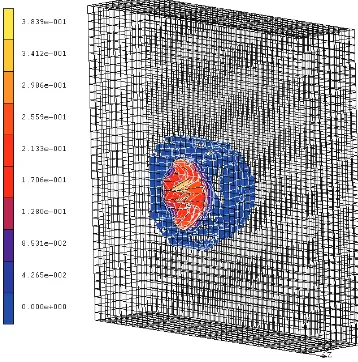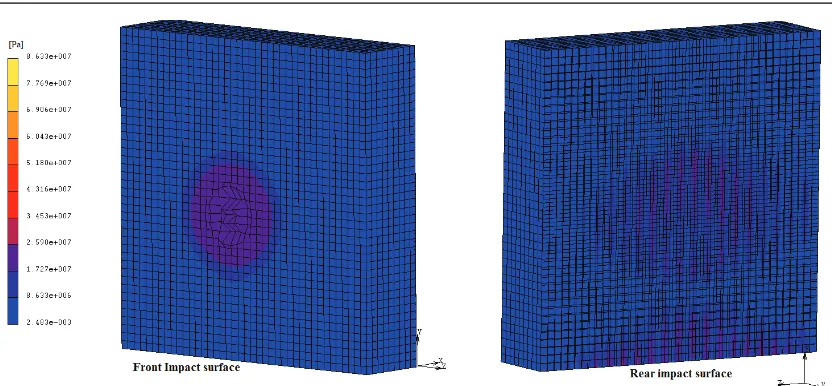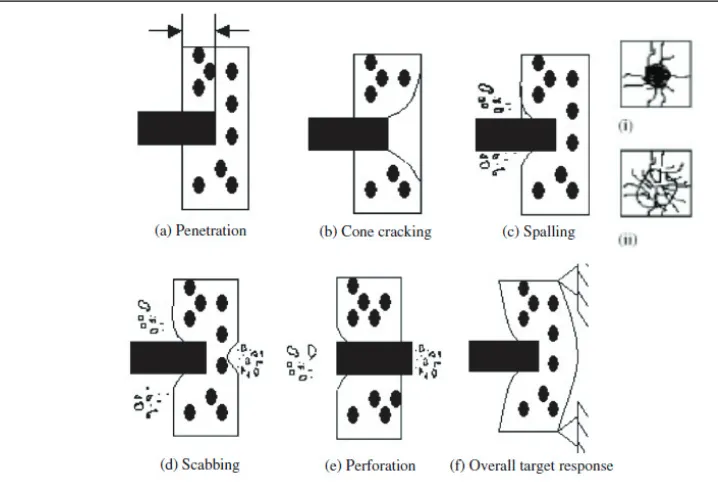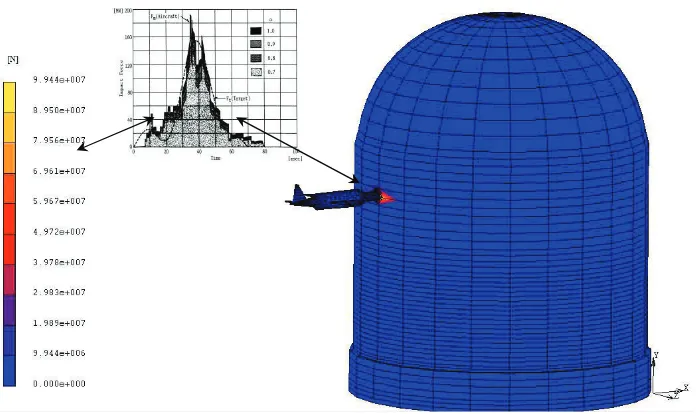AIRCRAFT IMPACT ONTO AN EXISTING NUCLEAR PLANT
Rosa Lo Frano1
1
Researcher, DICI- University of Pisa, IT
ABSTRACT
This study deals with the investigation of the damaging effects that the impact of a large civilian airplane could bring in safety relevant structures of a Gen II reactor.
The assessment of the safety margin of an existing plant, entails, unavoidably, with the evaluation of how robust the wall building is to guarantee the overall plant safety.
In doing that, the dynamic response of the RB has properly studied by means of a reliable finite element code and setting up further refined models of the reactor building and airplane. The location of the strike was considered near the junction of the dome and cylindrical body while the angle of incidence of the impact was assumed to be normal and/or inclined to the building outer surface.
Moreover the qualification of code has been done on the basis of the results of experimental carried out, simulating the impact of a missile against a deformable target. The results obtained, assuming the same impact velocity of the airplane, highlighted that:
1) the plant undergoes local damages in the area where the impact is localized;
2) the penetration depth is dependent on the type of aircraft considered and wall thickness; 3) the overall stability of the safety relevant structures is anyway ensured.
INTRODUCTION
The aircraft impact attracted the worldwide attention after the September 2001 event: the catastrophic damages (collapse of World Trade Center Towers) were caused by the striking of a large civilian airplane, specifically by the impact force applied on the buildings walls and by the fuel burning (responsible additionally of the reduction of mechanical properties of materials).
In consideration of such a type of damages, the demand of a much safer nuclear power plant (NPP) became obviously urgent. This is of course of strategic significance because the damage caused to the NPP may lead to the leakage of nuclear radiation.
In addition the (deliberate or accidental) aircraft impact is an accidental event felt of meaningful importance particularly in the existing plants that have been designed and constructed decades ago (with design criteria that did not take into account large airplane crashing), and whose materials are unavoidably affected by aging (Abbas, 1996; Lo Frano 2011; Lo Frano, 2013).
Many numerical studies and investigations on aircraft striking the containment structure have been conducted; however, numerical predictions are make difficult in terms of analysis methodologies, analysis programs, constitutive models, and elements erosion criteria because of the complexity of the phenomenon (local and global response). A critical review of all these methodologies and research findings used in the analysis of the aircraft impact is given in Jiang and Chorzepa, 2014, nevertheless the discussion is here limited to NPP outer CS, designed to house a reactor and primary system components.
phenomenon (“if the probability is smaller than the allowable value the phenomenon is neglected...”, Abbas, 1996), has not been covered in the present work.
Moreover, despite the fact that the International guide provides general information on this topic (i.e. regulatory requirements for beyond design basis), it does not include detailed procedures and material models to be used in characterizing the structural damage caused by the impact of a large and deformable structure like the aircraft.
To attain the purpose of this study an appropriate numerical model for aircraft impact has been developed; it has been validated against results from physical experiments before it is used for a complicated full-scale aircraft impact simulation of containment system (CS). The validation done was based on the experimental tests performed by Sugano et al., 1993 a and 1993b.
EXPERIMENTAL TEST: QUALIFICATION OF NUMERICAL CODE
The characterization of an impact phenomenon is a very difficult task from a physical point of view because it must be based on precise definitions and classifications, like that of the missile geometry, properties and material behaviour (to be deformable or hard) or those one related to the type of impact (i.e. soft impact) (Yankelevsky, 1997).
In the present paper, we are going to deal with a soft impact that is of interest because of the deformability (small or larger) of involved interacting structures and can be applied to the aircraft crash on concrete structures.
In a soft impact, there is no rebound, and the two mass points stick together; they become one single body after the crushing and the kinetic energy (depending on the “missile” velocity and mass) could be dissipated (Koechlin and Potapov, 2009). This assumption is based on what showed by the full-scale experiments performed by Sugano et al., in collaboration with the Sandia National Laboratories (Sugano et al.,1993 a, 1993b, 1993 c) and Muto et al. 1989: no rebound of the aircraft occurred.
a) b)
Figure 1. Full-scale aircraft impact test (a) and numerical model (b).
In the qualification analyses (by MARC© code, 2010), simulating the target-missile interaction above mentioned, the same initial and boundary conditions and the geometrical dimensions and material properties have been adopted along with a contact method (touching contact type).
The contact detection between all contact pairs was based on a double sided method; a piecewise linear approximation, based on the relative displacement between the bodies getting in contact, was also implemented.
Analysis of the results
Figure 2 shows the progression of the damage as the airplane penetrates into the target wall and the damage caused by the impact force (Sugano et al, 1993c; Riesemann et al., 1989): from top left snapshot to the bottom right one impact, penetration, spalling and crater formed are visible.
Since the target wall was penetrated, the reinforcing rebars resulted uncovered (as visible in Figure 2). Indeed no perforation occurred.
measured experimentally, like the stress distribution. Figure 5 shows as the impact stress distributed over the rear surface: even if in some point it reaches the allowed limit it did not determine any scabbing.
a) b)
Figure 3. Penetration depth (a) and fragments projection (b).
Figure 5. Von Mises stress distribution at 2.1 msec from the impact.
AIRCRAFT IMPACT SIMULATION
Based on what already said and because of its safety concern, we have to prove, and build confidence in, the safety of the OCB and the consequences on the environment and humans are negligible by means of safety assessment and calculations.
For NPP, it can be characterized by major structural damage, such as the collapse of large portions of the building walls, load carrying members, etc. apart from the potentially vibrations that could be induced throughout the building. The extent of such a global failure will depend primarily on the dynamic characteristics of OCB and the missile, and the relative damage is, in the general case, associated with the excessive deformation of the entire structural system, assuming that local perforation does not occur. As for the local effects concerned, Kennedy (1976) identified seven phenomena, as shown in Figure 6: (a) penetration, (b) cone cracking and plugging, (c) spalling - ejection of target material from the proximal face of the target -, (d) radial cracking, (e) scabbing - ejection of fragments from the distal face of the target -, (f) perforation, and (g) failures.
Such local damages would not, in general, determine a structural collapse, but instead are considered because of their potential to damage safety related systems or components.
In view of that two distinct structural failure modes need to be evaluated: the local and the global failure (local and global response).
The safety assessment of a OCB requires that it must have a minimum wall thickness capable to prevent the perforation, even in presence of penetration and scabbing (DOE, 1996), and fire inside containment as part of the requirement for continued core cooling, as indicated in 10 CFR 50.150 and NEI 07-13 (2011)
Figure 6. Identification of possible damages of an impacted concrete target.
Modelling
The outer containment object of the safety assessment was that of a typical PWR (60 m tall, about 45 m in diameter and 1 m thicker)assumed to rest on rock soil (“rigid foundation”), that are simulated by clamped restraints. Three main part may be identified: the basement, the cylindrical body and the dome.
Based on the containment shell 3-D description, given in Lo Frano and Forasassi, 2011b and Smith and Cherry, 1998, the FEM model implemented with MSC©MARC code to be used for the numerical simulations, complies with the characteristics indicated in the ASCE rules and ACI standards. Specifically, it has #8 reinforcing steel bars in the dome distributed at about 30 mm on centre each way and each face; in the cylindrical walls they are #18 vertical bars at about 30 mm spacing for each face and #18 horizontal bars on both sides of the vertical reinforcing grid. In the basement instead, there are steel plates of 13 mm thickness. A scheme of such a type of containment is represented in Figure 7.
The FEM model, shown in Figure 7 required more than 68.000 solid element: the concrete structure and main body of airplane were modelled by SOLID-3D elements, internal structures using 3-D thick shell and steel rebars by TRUSS-3D elements. Adequate initial and boundary conditions (continuum mechanics) have been assumed so as to preserve energy and momentum. The contact force is automatically calculated by the code based on the conservation of the impulse. Further restrictions and simplification have been also imposed to the plane velocity (assumed constant), impact direction, and for what concerned the geometry of the OCB internal components.
The aircraft crashing was simulated by performing nonlinear transient analysis and assuming the updated Lagrangean procedure and large deformation. The time step of the analysis was of 1E-5 s.
In addition a touching contact type algorithm has been implemented, along with the contact detection, between all contact pairs based on a double sided method; the criterion used to decide whether or not a node in contact should separate is stress-based.
Airplane and steel reinforcement were instead assumed to behave as elastic-perfectly plastic: for the former Cowper-Symonds model was implemented.
(a) (b)
Figure 7. OCB model section (a) and reinforcement (b).
In the analyses two strike location for detailed analyses are identified: 1) just above the equipment hatch; 2) on the dome. In both cases a horizontal impact (Figure 8) was assumed to consider the worst accident scenario.
Figure 8. Horizontal aircraft impact configuration.
ANALYSIS OF RESULTS: DISCUSSION
Figure 9. Impact force on target.
As a result of the impact, the containment building deforms beyond up to the point of permanent yielding; a narrow cone is formed at the entry location; the outer wall of containment resulted so penetrated.
Figure 10. Stresses generated on both airplane and OCB at fuselage crashing.
Figure 11 showed the distribution of stresses at the stricking loaction, in particular at the outer and inner impacted containment surface. The stress values indicate that the structural failure of OCB does not occur, even in presence of ongoing progressive failure (cracking), due to the overall robustness of structure that resulted anyhow capable to absorb the impact energy.
Furthermore the penetration depth ranged between 2.3 to 5.8 cm, accompanied by cone cracking and some spalling of concrete wall. No perforation of the OCB wall appeared.
a)
b)
Figure 11. Stresses (at outer and inner impacted surface) (a) and penetration depth on the OCB (b).
It was also observed that the propagation of dynamic loading inside the NPP (vibrations), with acceleration value of about 52 g did not determine relevant displacements that could trigger the internal structures, particularly the containment vessel.
CONCLUSION
The following conclusions were obtained in the tests: 1) the mean value of the penetration depth was about 5 cm; 2) the steel lining is effective in preventing scabbing; 2) the stress values indicate the presence of ongoing cracking, 3) despite the airplane penetrates half the thickness of the containment (narrow cone formed) no perforation occurred.
Moreover the qualification of FEM code (very good agreement) used has been done on the basis of the experimental results available in literature.
Generally the local effects (penetration and spalling) do not pose a threat to the safety-related systems necessary to shut down the nuclear plant.
Jiang, H., and Chorzepa,M. (2014), “Aircraft Impact Analysis of Nuclear Safety-Related Concrete Structures: A Review”, Engineering Failure Analysis, 46, 118–133.
Sugano, T et al. (1993) a. “Local damage to reinforced concrete structures caused by impact of aircraft engine missiles Part 1. Test program, method and results”. Nucl. Eng and Design;140, 387-405. Sugano, T., et al.(1993) b. “Local damage to reinforced concrete structures caused by impact of aircraft
engine missiles Part 2. Evaluation of test results”. Nuclear Engineering and Design; 407-23.
Yankelevsky, D., (1997). “Local response of concrete slabs to low velocity missile impact.” Int. J. Impact Eng. 19 (4), 331–343.
Koechlin, P., Potapov, S.(2009).” Classification of soft and hard impacts-Application to aircraft crash” Nuclear Engineering and Design 239, 613-618.
Sugano, T. et al. (1993)c. “Full-scale aircraft impact test for evaluation of impact force”. Nuclear Engineering and Design, 140, 373–385.
Muto, K., et al.(1989) “Experimental studies on local damage of reinforced concrete structures by the impact of deformable missiles. Part 3: Full-scale Tests” Proc. of 10th SMIRT Conference.
MSC©Software (2010), MSC.MARC user’s guide.
Riesemann, W.A., et al.(1989). “Full-scale aircraft impact test for evaluation of impact forces Part 1: Test plan, test method, and test results”. Proc. of 10th SMIRT Conference.
Kennedy, R.P., (1976). “A review of procedures for the analysis and design of concrete structures to resist missile impact effects”, Nuclear Engineering and Design, 37, 2, 183-203.
Department of Energy -DOE, (1996). ”Accident analysis for aircraft crash into hazardous facilities” DOE-STD-3014-96, USA.
NEI 07-13, Rev. 8, (2011). “Methodology for performing aircraft impact assessments for new plant designs”. Washington, DC.
Lo Frano R., Forasassi G., (2011)b. ”Preliminary evaluation of the reliability of Gen II or III reactors in BDBE conditions”, Proceedings of the 2012 20th ICONE20-POWER2012, July 30 - August 3, Anaheim, California, USA
Smith, J. A., and Cherry, J. L.,(1998) “Analyses of a Reinforced Concrete Containment with Liner Corrosion Damage”, NM 87185-0744, Sandia National Laboratories, Albuquerque.






